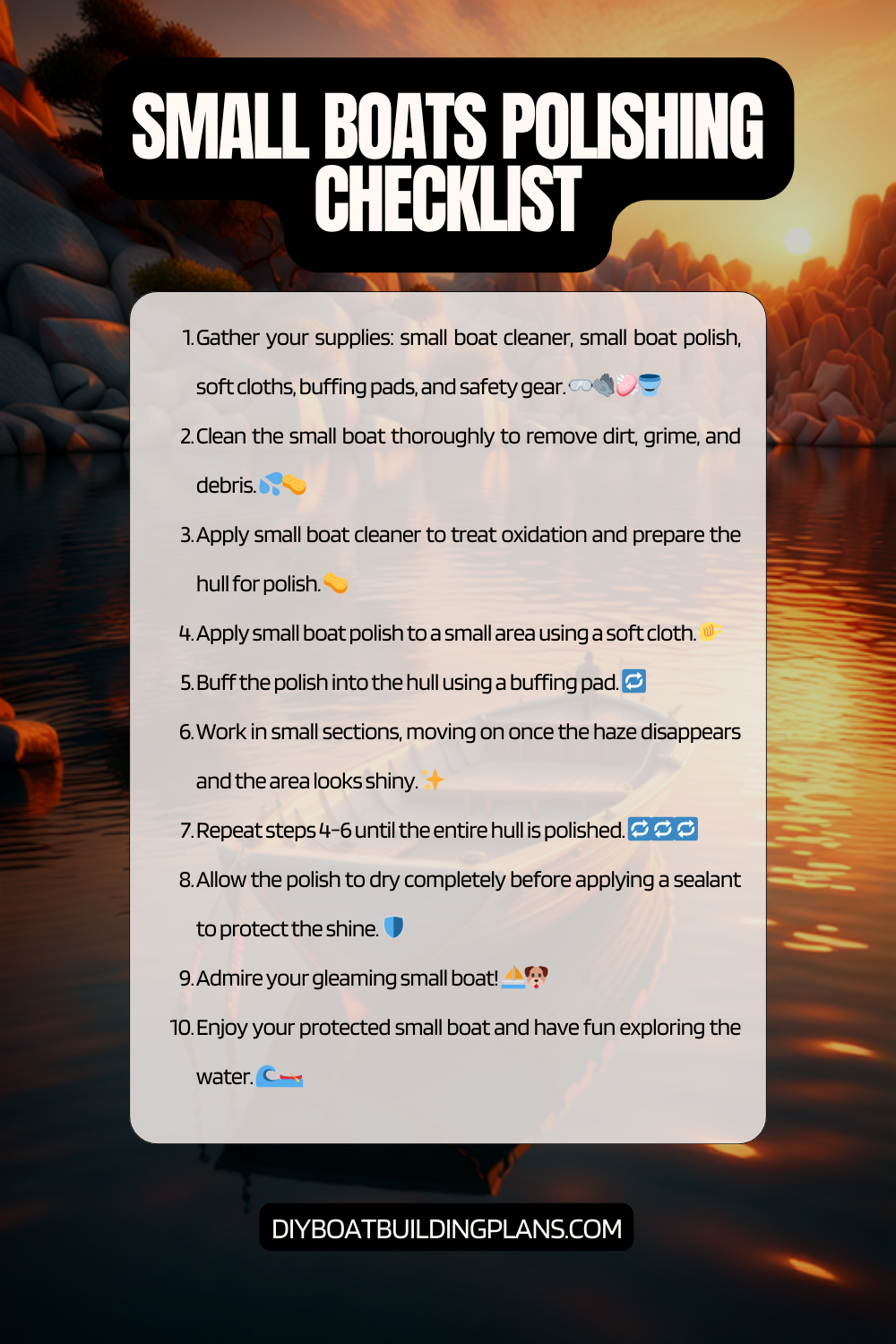Overview of Small Boat Polishing Tips
Small boat polishing is the process of restoring and enhancing the appearance of your small boat by removing imperfections and bringing back its shine. It involves using specialized products and techniques to remove scratches, oxidation, and other blemishes from the boat’s surface. Polishing your small boat is not just about aesthetics; it is also essential for maintaining the overall condition and value of your vessel.
Maintaining the appearance of your small boat is crucial for several reasons. Firstly, a well-maintained boat not only looks more appealing but also reflects positively on its owner. Whether you use your boat for personal enjoyment or as a means of income, a clean and polished vessel creates a positive impression on others. Additionally, regular polishing helps protect your boat’s surface from the damaging effects of the sun, saltwater, and other environmental factors.
Key Takeaways
- Polishing your small boat is important to maintain its appearance and protect it from damage.
- Choosing the right polishing products and preparing your boat properly are key to achieving a great result.
- A step-by-step guide can help you polish your boat effectively, including hard-to-reach areas.
- Removing scratches and oxidation requires specific techniques and products.
- Maintaining your boat’s shine after polishing involves regular cleaning and protection.

Why Polishing Your Small Boat is Important
Polishing your small boat offers numerous benefits beyond just improving its appearance. One of the primary advantages is the protection it provides against environmental factors. The sun’s UV rays can cause fading and deterioration of your boat’s gel coat over time. By regularly polishing your boat, you create a protective barrier that shields it from these harmful rays, preventing premature aging and maintaining its vibrant color.
Furthermore, polishing helps to remove oxidation, which is a common problem for boats exposed to saltwater or harsh weather conditions. Oxidation occurs when the gel coat becomes dull and chalky due to exposure to UV rays and other elements. Polishing not only restores the shine but also eliminates oxidation, ensuring that your boat looks its best.
Choosing the Right Polishing Products for Your Small Boat
When it comes to choosing the right polishing products for your small boat, there are several options available in the market. The most common types include rubbing compounds, polishes, and waxes. Rubbing compounds are more abrasive and are used to remove deep scratches and oxidation. Polishes are less abrasive and are used to restore shine and remove light imperfections. Waxes, on the other hand, provide a protective layer and enhance the boat’s shine.
When selecting a polishing product, it is essential to consider factors such as the condition of your boat’s surface, the level of imperfections you need to address, and the desired outcome. If your boat has significant scratches or oxidation, you may need a more aggressive rubbing compound. However, if your boat’s surface is in relatively good condition, a polish or wax may be sufficient. It is also crucial to choose products specifically designed for marine use to ensure optimal results.
Preparing Your Small Boat for Polishing
| Task | Time Required | Tools Needed | Materials Needed |
| Clean the boat | 1 hour | Bucket, sponge, boat soap | Boat soap, water |
| Remove oxidation | 2-3 hours | Buffer, polishing pad, oxidation remover | Oxidation remover, microfiber towels |
| Polish the boat | 2-3 hours | Buffer, polishing pad, boat polish | Boat polish, microfiber towels |
| Apply wax | 1-2 hours | Buffer, waxing pad, boat wax | Boat wax, microfiber towels |
Before you begin the polishing process, it is crucial to properly prepare your small boat. Start by thoroughly cleaning the boat’s surface using a mild detergent and water. Remove any dirt, grime, or salt residue that may be present. Once cleaned, rinse the boat thoroughly and allow it to dry completely.
If your small boat already has existing wax or polish on its surface, it is essential to remove it before applying a new layer. This can be done using a specialized wax remover or by gently sanding the surface with fine-grit sandpaper. Removing the old wax or polish ensures that the new product adheres properly and provides optimal results.
Step-by-Step Guide to Polishing Your Small Boat
To achieve a professional finish when polishing your small boat, follow these step-by-step instructions:
1. Start by applying a small amount of rubbing compound to a clean microfiber cloth or applicator pad.
2. Work in small sections, applying the rubbing compound in circular motions.
3. Apply moderate pressure while buffing the surface, focusing on areas with scratches or oxidation.
4. Continue buffing until the imperfections are removed and the desired shine is achieved.
5. Once the entire boat has been polished, wipe off any excess compound using a clean microfiber cloth.
6. Repeat the process with a polish, using the same circular motions and moderate pressure.
7. After polishing, apply a layer of wax to protect the boat’s surface and enhance its shine.
8. Allow the wax to dry according to the manufacturer’s instructions, then buff it off with a clean microfiber cloth.
Tips for Polishing Hard-to-Reach Areas on Your Small Boat
Polishing hard-to-reach areas on your small boat can be challenging but not impossible. Here are some techniques and tools that can help with the process:
1. Use smaller applicator pads or cloths to reach tight spaces. This allows for better control and maneuverability.
2. For areas that are difficult to reach by hand, consider using a polishing tool with a smaller pad attachment.
3. Use specialized polishing brushes or detailing brushes to access crevices and corners.
4. If necessary, disassemble removable parts or components to gain better access for polishing.
5. Take your time and be patient when working on hard-to-reach areas. It may require extra effort, but the results will be worth it.
How to Remove Scratches and Oxidation from Your Small Boat
Scratches and oxidation can significantly detract from the appearance of your small boat. Here are some methods for removing them:
1. For light scratches, start by using a polish with mild abrasives. Apply it in circular motions until the scratches are minimized or removed.
2. For deeper scratches, use a rubbing compound with more aggressive abrasives. Apply it in the same manner as the polish, focusing on the scratched area.
3. If oxidation is present, use a rubbing compound specifically designed for oxidation removal. Apply it in circular motions until the oxidation is eliminated.
4. After removing scratches and oxidation, proceed with the polishing process to restore shine and protect the boat’s surface.
Maintaining Your Small Boat’s Shine After Polishing
To maintain the shine of your small boat after polishing, follow these tips:
1. Regularly wash your boat with a mild detergent and water to remove dirt, salt, and other contaminants.
2. Avoid using abrasive cleaners or brushes that can scratch the surface.
3. Apply a fresh coat of wax every few months to provide ongoing protection and enhance the shine.
4. When not in use, store your boat in a covered area or use a boat cover to shield it from the elements.
5. Avoid prolonged exposure to direct sunlight, as it can fade the boat’s gel coat over time.
The frequency of polishing your small boat depends on various factors such as usage, environmental conditions, and personal preference. As a general guideline, it is recommended to polish your boat at least once or twice a year. However, if you notice signs of oxidation or significant loss of shine, it may be necessary to polish more frequently.
Download over 500 Boat Plans. Click on the link below.
-->Click Here<--
Common Mistakes to Avoid When Polishing Your Small Boat
While polishing your small boat can yield excellent results, there are some common mistakes that you should avoid to prevent damage:
1. Using abrasive products or tools that are too aggressive for your boat’s surface can cause scratches or further damage.
2. Applying too much pressure while polishing can also lead to scratches or swirl marks.
3. Neglecting to properly clean and dry your boat before polishing can result in poor adhesion of the products and subpar results.
4. Overlooking hard-to-reach areas can leave them dull or oxidized, affecting the overall appearance of your boat.
5. Failing to follow the manufacturer’s instructions for the polishing products can lead to ineffective results or potential damage.
Small Boat Polishing Checklist

Conclusion – Small Boat Polishing Tips
In conclusion, small boat polishing is an essential aspect of maintaining the appearance and value of your vessel. By regularly polishing your boat, you not only enhance its shine but also protect it from environmental factors such as UV rays and oxidation. Choosing the right polishing products and properly preparing your boat are crucial steps in achieving professional results.
Follow a step-by-step guide when polishing your small boat, paying attention to hard-to-reach areas and using appropriate tools and techniques. Remove scratches and oxidation using suitable products and maintain the shine by regularly washing and applying wax. Avoid common mistakes that can damage your boat’s surface and refer to frequently asked questions for additional guidance.
By investing time and effort into small boat polishing, you can enjoy a beautiful and well-maintained vessel that stands out on the water. So, grab your polishing products and get ready to transform your small boat into a shining masterpiece!
FAQs – Small Boat Polishing Tips
What is small boat polishing?
Small boat polishing is the process of removing oxidation, stains, and scratches from the surface of a small boat to restore its shine and protect it from further damage.
Why is small boat polishing important?
Small boat polishing is important because it helps to maintain the appearance and value of the boat. It also helps to protect the boat from the damaging effects of the sun, saltwater, and other environmental factors.
What are some tips for small boat polishing?
Some tips for small boat polishing include using a high-quality polishing compound, working in small sections, using a polishing pad or cloth, and applying a protective wax or sealant after polishing.
What tools and materials are needed for small boat polishing?
Tools and materials needed for small boat polishing include a polishing compound, polishing pad or cloth, buffer or polisher, protective wax or sealant, and a hose or bucket of water for rinsing.
How often should small boats be polished?
Small boats should be polished at least once a year, or more often if they are exposed to harsh environmental conditions such as saltwater or intense sunlight.



